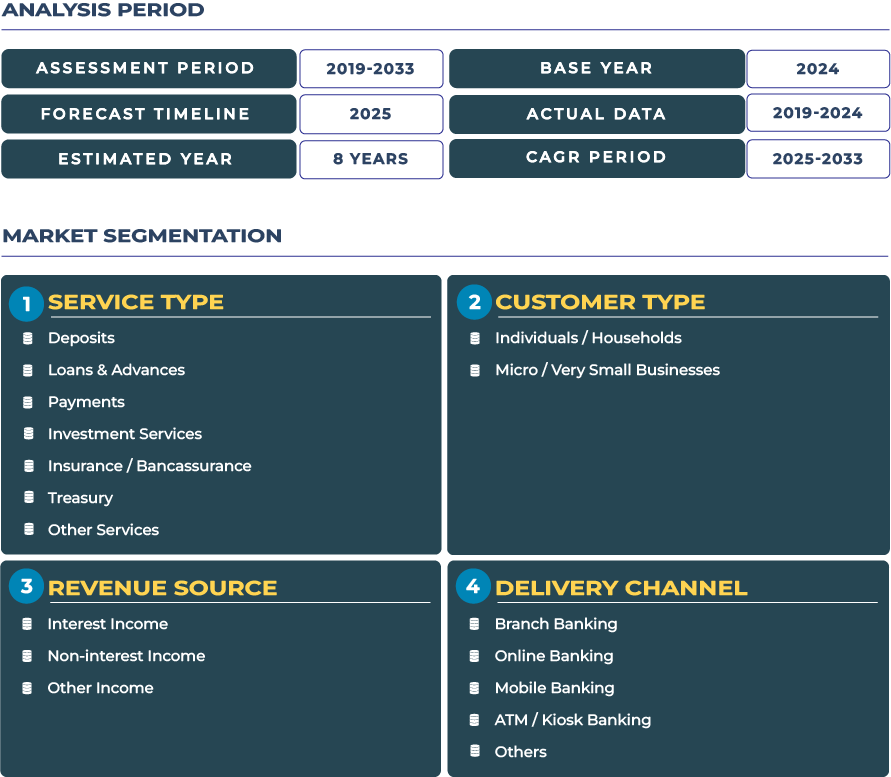AI-Enhanced Credit & Risk Management: France Retail Banking Market in Transition
France is increasingly adopting AI-based models in credit scoring, risk management, and fraud detection to fortify trust while innovating customer decision engines. Leading banks are piloting machine learning models that analyze alternative data-transactional behavior, social indicators, real-time spending-to refine creditworthiness and preempt defaults. These capabilities strengthen underwriting discipline and enable more dynamic pricing across consumer segments.
Note:* The market size refers to the total revenue generated by banks through interest income, non-interest income, and other ancillary sources.
Market Outlook: Strategic Trajectory Through a Risk-Intelligent Lens
Over the 2025–2033 horizon, France retail banking sector will navigate stable but constrained growth. The projected rise from USD 108.1 billion to USD 124.9 billion (1.8% CAGR) underlines the structural ceiling in a developed market. Core volumes-deposits, mortgages, personal loans-will remain foundational, albeit with margin compression in a low yield environment and regulatory cost pressure. Thus, the frontier for uplift lies in non-interest income: payments monetization, embedded and usage-based insurance, wealth advisory, and dynamic credit services. In parallel, macro and geopolitical forces-interest rate cycles, inflation, energy cost volatility in Europe, and spillover from global tensions-will exert pressure on consumer borrowing and deposit behavior. French institutions that lean into AI-enabled decisioning, streamline cost bases, and orchestrate bundled financial journeys will better capture wallet share and sustain margins in a competitive environment.
Drivers & Constraints: Deconstructing France Retail Banking Momentum
Driving Engine: Contactless Adoption & Fintech Dynamism
A key growth driver in France retail banking is the rapid uptake of contactless payments, mobile wallets, and digital banking usage. Consumers now expect near-instant, frictionless experiences, pushing banks to optimize digital funnels and payment rails. The fintech ecosystem in France is flourishing: startups like Lydia, Qonto, and others are reshaping consumer and SME finance models. The country’s regulatory and institutional support-via the Autorité des Marchés Financiers (AMF) and open banking mandates-fosters a conducive environment for innovation. French banks are launching API sandboxes, real-time payment pilots, and collaborative ventures to augment their core offerings. This confluence of consumer behavior, regulatory stimulus, and fintech competition propels digital adoption, usage frequency, and latent monetization across payment, lending, and advisory segments.
Constraining Pressures: Regulatory Overhead & Operational Cost Rigidities
On the flip side, regulatory complexity and cost rigidity constrain acceleration. France banking sector operates under stringent rules-capital, conduct, data privacy, anti-money laundering frameworks-that increase compliance burden and slow innovation rollout. Legacy branch infrastructures and personnel costs impose high fixed costs that are harder to shrink in dense urban markets. Further, scaling AI and data models requires robust governance, explainability, and validation frameworks, especially under European and French supervisory scrutiny. Customer trust mandates caution: algorithmic bias, data misuse, or system failures can provoke reputational damage or regulatory backlash. In sum, while innovation potential is high, the path is constrained by structural overhead, risk governance, and cost leverage challenges.
Trends & Opportunities: Emerging Patterns in France Retail Banking Landscape
Trend: Rise of Mobile Apps, Peer-to-Peer Payments & Smart Credit Interfaces
One prominent trend in France is the scaling of mobile banking as the central interface for consumer finance. Apps are evolving beyond basic balance and transfer functions to include smart notifications, personalized insights, and embedded credit offers. Peer-to-peer payment solutions are becoming mainstream, competing with traditional interfaces and lowering friction across social and commerce transactions. Fintechs and neobanks are pushing real-time lending and credit lines accessible in-app. The shift from offline branch interactions to digital engagement is accelerating, reshaping how consumers interact with retail banking institutions.
Opportunity: AI-Driven Customer Intelligence & Wallet Expansion via Embedded Services
A critical opportunity lies in embedding AI models for customer insights, segmentation, and predictive triggers. Banks can identify cross-sell moments, detect churn signals, and present dynamically tailored product bundles. In credit, AI scoring enables micro-lending, point-of-sale finance, and dynamic interest pricing. Another opportunity is expansion of mobile wallets and embedded finance: integrating banking into e-commerce, transport, and social platforms transforms banking from a distinct service to an integrated utility. Institutions that deliver seamless payment, lending, insurance, and loyalty services in one mobile environment can deepen engagement and monetize more of the customer’s ecosystem.
Competitive Landscape: Strategic Moves Among French Retail Banking Leaders
Major French banking groups-BNP Paribas, Crédit Agricole, Société Générale, BPCE, and Crédit Mutuel-are evolving strategies to defend relevance and scale digitally. Société Générale, for instance, is ramping up its digital offerings and refining cost structures to offset low interest rate pressures. Meanwhile, BNP Paribas is targeting profit rebound in its French retail arm, CPBF, by 2028, with plans to reduce branches and operational overhead, and leveraging AI to streamline processes. In payments, BNP Paribas and BPCE have launched a joint venture to build a pan-France payments processor, aiming to scale transaction infrastructure and reduce external reliance. Some banks are acquiring fintechs or launching internal lab units to accelerate innovation. Yet incumbents must guard against cannibalization of core business while migrating to platform models. The competition is not simply product parity but executing seamless, data-driven, risk-aware banking delivery in a digitizing consumer environment.







